A view on emerging Chinese shoemakers
Over the past two or three years, a group of mostly Chinese shoemakers has come to prominence for making high quality, usually hand-welted shoes at relatively cheap prices.
I’ve experienced some of these, and talked to those in the industry about others. Given the questions that have been starting to pop up from readers, I thought it would be useful to set out my general thoughts and reflections on them. I may then cover some in more detail later in the year.
It probably shouldn’t surprise anyone to learn that the shoes are cheap(er).
The lower labour costs in China make everything less expensive, from constructing the shoes themselves to the price paid for lasts (everyone seems to use the same lastmaker, much like Springline in the UK).
A pair from Chinese brand Yearn, for example, costs £370 (inc. VAT). That’s not only hand lasted and hand welted, but the outsole is sewn by hand as well. Work only a bespoke shoe in Europe has, at several times the price.
Of course, that’s assuming the quality of materials is the same, which they may not be. That’s something best assessed in a fuller review, with the shoes having been worn and worn and worn and polished.
But you can certainly see why these brands would appeal to someone that aspires to a top-end English or French maker, but can’t quite afford them.
Most of these makers are not new. The people running the workshops have often been doing so for 20 or 30 years, largely supplying Chinese and Japanese domestic markets.
The difference is that they’re now specifically targeting the west, and tweaking the way shoes are made to give them bespoke or high-end touches (bevelled waists, pitched heels) or introducing familiar designs.
Often the driver of this change has been local shoe enthusiasts, in China or Hong Kong, with an awareness of shoemaking in the west. People like Maslow So at Mori, Phoenix Fu at Yearn, Jerry Tong at Prologue/Takano Keitaro and others have brought their knowledge of western markets to existing producers, just as others have done with Spanish makers in the past.
The workshops in China vary considerably in size, location and exclusivity. One of the largest, TGC in Shanghai, makes for Yeossal, Oct Tenth and does some of Mori's process. Yearn uses a workshop that has a domestic brand called Slim Shoes, while Acme - shown above, probably the best regarded currently - has its own small operation.
They’re based all around the country, in Beijing, Shanghai, Hong Kong, Guangzhou and Chengdu.
So far I’ve tried three, mostly when I’ve come across them, or they happen to get a UK distributor. Those are Mori, Yearn and Takano Keitaro. I’m also in the process of having a pair made at Acme.
I’ve been very impressed with all three, particularly with the fineness of the make, which would be good even at a much higher price.
The aforementioned pitched heels and bevelled waists are a consistent feature, while they revel in decorative touches like the edge pattern, shaped heel rubber and painting on the sole of my Takano Keitaro pair above.
But even subtle points like the segue from sole to heel on the side - often an area where makers like Alden show their roughness - are nicely done.
However, I have also found little mistakes and consistency issues.
The first pair of Mori shoes I tried, for example, had an issue with the sole coming away at the front. That was four years ago, and is now not an issue apparently, but I’m waiting for a follow-up pair to try again.
The Takano Keitaro pair had an interesting pattern of stitching on the upper, with three different lines in places. But the line on each toe bent in a different direction - one slightly forward, the other slightly back (above).
And the Yearn shoes I tried had an antique-like patina, but one which wasn’t applied to some of the tongue, leaving a small semi-circle of colour at the top (below).
These are only three instances of course, but the makers said they were caused by production issues, so it feels fair to say that some of the workshops are having problems making new styles or to new standards.
By comparison, in the dozens of Northampton shoes I’ve owned or tried over the years, I’ve only come across a similar issue once, with Alfred Sargent.
Another thing worth highlighting is that some of the Chinese makers tend towards a certain style, characterised by slim lasts, often chiselled shapes and slightly flashy styles.
The green soles on that Takano Keitaro pair are a good example, and the two Yearn pairs I tried both used a version of museum calf, with its patchy aged look. I know many shoe enthusiasts like this effect, but for me it always looks fake. Certainly, it is aimed at customers with a particular taste.
The lasts meanwhile, I found too slim for my feet in a regular E fitting most of the time, and was recommended to try something wider.
One of the brands put this down to local taste: “Asian people generally have shorter and wider feet, so they want the opposite - something that is long and slim,” they said. Which makes sense, although if people have feet that are shorter and wider than mine, I would have thought these lasts would be even harder to fit.
These are all generalisations of course. Everyone does wider fittings, and there are very conservative styles alongside the bolder ones. But based on my experience so far, the tendency does seem to be more towards a French aesthetic or at least, in the UK, a Gaziano & Girling, rather than something more classic.
One of the people I spoke to for context, alongside a few at brands, was Justin Fitzpatrick, an old friend and the founder of The Shoe Snob. He has tried and written about several of these makers.
“The brands and their quality have come a long way in the past few years,” he says. “It’s all happened very quickly, and been very impressive. I have seen some have some teething issues though, which is probably inevitable when you’re setting up a new operation or introducing new processes.
“I think for the moment the market is mostly limited to guys that really want a shoe with bespoke aspects, but can’t stretch to those makers elsewhere. It will only be when those issues are ironed out, and the brands start to have stockists in Europe or the US, that they could become a threat to the established shoemakers.”
I probably agree. As a western consumer that can afford the top RTW makers, I’m not going to ship shoes back and forth from China, particularly if there are any production issues or the sizing is hard to get right.
It’s good to save the money of course, but I’d prefer to walk into a shop here and try everything, see the product up close, and have someone to go back to with any problems. And when there are stockists and shops over here - or at least trunk shows - the Chinese brands will probably be a little more expensive.
Still, that doesn’t mean I won’t continue to cover them, so everyone can make up their own mind. The first full review will likely be of Acme, in a month or so.
If anyone would like more detailed information on the Chinese makers, and others from around Asia, check out the articles on Justin’s blog here.
The shoes pictured, top to bottom, are: Mori, Acme, Takano Keitaro (sole), Takano Keitaro (upper), Yearn, Acme, Mori.


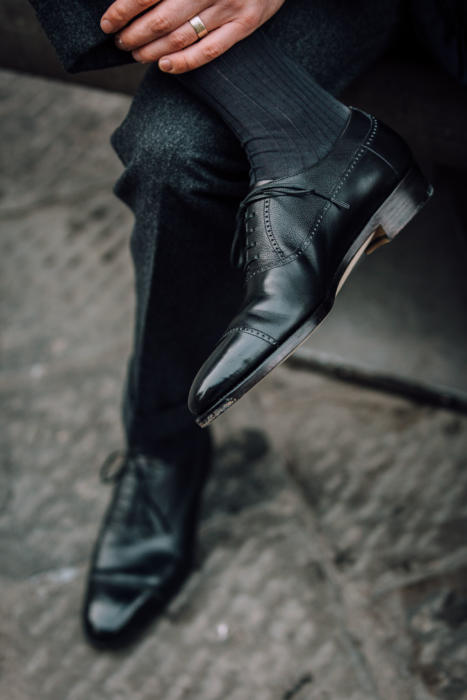
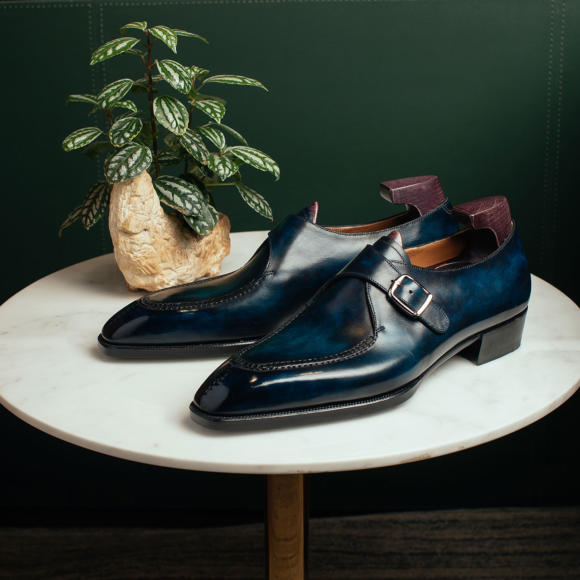
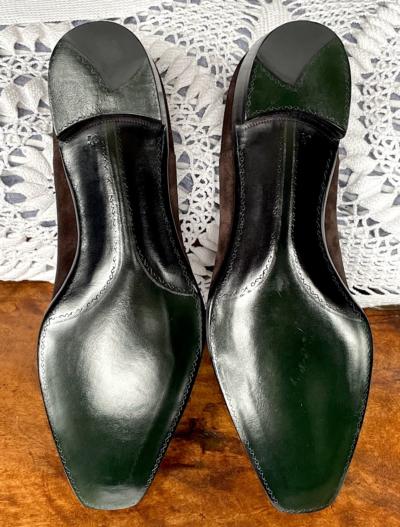
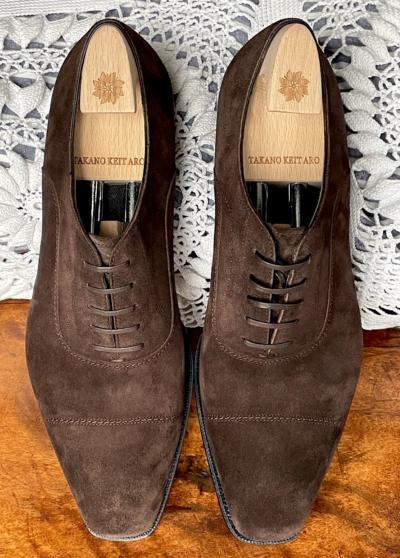
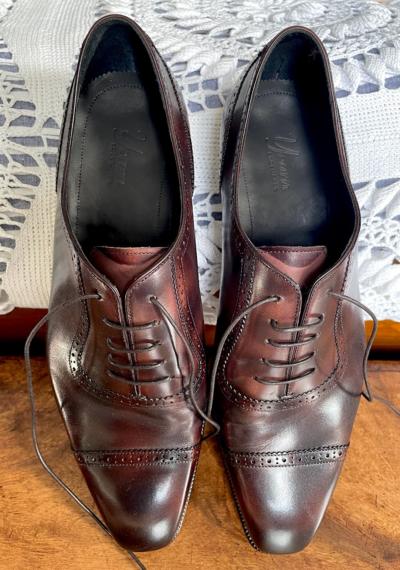
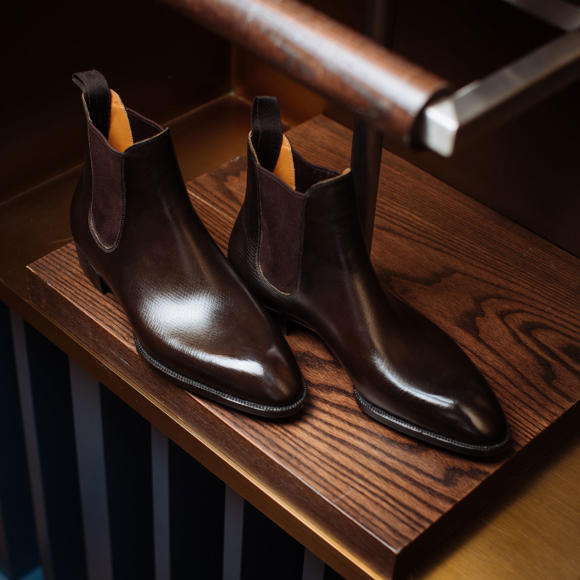
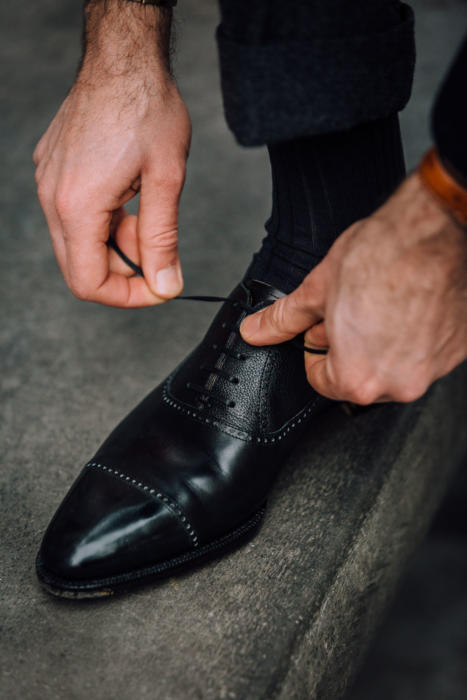


























The issue regarding the difference is shoe size and shapes in asia is really significant. I believe that many English shoes made specifcaly for the market in the far east are sized differently. I bought some Trickers that were imports to the far east and they were significantly different, though wearable, to uk sizing. Do you think these makers would have taken account of regional variations in foot morphology when supplying to the UK?
Yes, that’s right Darryl, a lot of brands make different sizing for Asia – obviously for things like tailoring too. It’s a question of body shape but also of taste.
Is it actually more expensive to have pitched heels – isn’t it just done by smoothing out the heels at an angle instead of just straight (i.e., it maybe takes 5 extra minutes on a sanding machine)? I like the look and it has always slightly annoyed me that even Edward Green only do it for their top drawer line.
I don’t know how long it takes, but actually 5 minutes or so of extra work is quite a lot. Plus someone else checking it, refining any mistakes etc. A lot of jobs are that kind of level of work, but they quickly mount up.
It also requires more skill, so a more expensive worker, and is more prone to mistakes. Much easier to simply stack the heel layers at the same size.
It is not more difficult to do the tapering, you just have a sanding machine that has a different setting. The difference is that to have a nice look with a tapered heel on dress shoes, you have to cut the heel close to the uppers. The closer you get, the more difficult it is to make it look even and nice and to not damage the upper. For premium brands like EG they surely could do it if they felt the value of getting a new machine for it (Top Drawer is tapered “manually” on a sanding wheel, not the same type of machine where you otherwise do the basic straight trimming or tapering), but think they don’t have enough interest from customers for this so they just skip it.
Did you experience high import taxes when your received your pairs? Living in the EU, it has been a concern of mine recently.
No, but then of course the EU might have different arrangements with China/HK than the UK now, I don’t know
Hi Simon, just a quick question from your reply above. I live in London like you but have always been afraid ordering from HongKong as I am not sure of the extra taxes and duties that might incur.
If I get something shipped from Armoury HK, do you know if I will incure taxes/duties since you didnt get hit when you got your shoes from HK/China?
I’m not sure to be honest Andy – it’s best to check with The Armoury themselves rather than go on just my experience
I received a pair of Acme a couple of months ago (EU) and was surprised to have been taxed way less proportionally than the G&Gs I have ordered since Brexit. YMMV, obviously.
Hard to fault my Acme pair. Honestly, one of the best RTW shoes I’ve ever had and look forward to wearing them more. I’d highly recommend them for their products and their customer service.
This is a very honest review, Simon! I also feel that some Chinese shoemakers are really impressive at first glance (in terms of fineness of the work), but oftentimes they get some basic things wrong or awkward, such as style and fit. Even not to mention the availability factor you noted above. That’s why, even as a Chinese living in the UK, I opt for buying EG or Saint Crispin’s in the end.
That said, however, I still think the future of Chinese bespoke shoes could be very promising in the next couple of years. The shortness of availability and style could be massively improved when the market gets ripened and matured. I am quite optimistic about that.
Look forward to reading your follow-up articles!
Pleased to hear it Chuyu, and interesting to hear you take the same view, given you can clearly afford those more expensive brands as well.
I should have mentioned that Yearn do actually have a UK representative, Arterton. But they don’t have a shop or physical presence either, so you save on shipping issues but not the ease of a local stockist
Thank you Simon, I missed the detail “Arterton” in your article. But I will definitely check it out.
Yeah, I kind of save a lot to buy better quality shoes. (Buy less, but buy better, as you put it). Hopefully I won’t offend anyone that I dislike the ‘general’ flashy style of Chinese shoes, but as I wished, as the market matures, many aspects could be improved a lot!
Thank you for the review and I look forward to a review of a specific pair .
Having read PS for probably a decade I really appreciate when you look beyond your traditional market .
Let’s not be so defensive of foreign competitors .
There’s plenty of room for everyone .
If anything , at these price points I can see new entrants into the bespoke shoe market.
I mean if it wasn’t for Cheaney , Church’s etc factory sales I’d still be wearing Clarkes !
I think its worth noting that for people who dont live in an area with access to the typical European high-end makers from England, Italy or France it isnt much different to “order” shoes online from china or elsewhere. Very few shops, even in Europe, sell those.
I have communicated with a few asian makers and they always seem very helpful and easy to interact with. I would however also argue that some of them, like Acme, are not “cheap” and charge prices that aren’t too far off from bespoke or MTO prices in the high-end European market.
Thanks Rune, good point on location
Interesting overview of world of Chinese bespoke shoes. I’ve personally always found it a bit confusing so thanks for this piece.
Maslow of Mori is also the owner of Il Negozio tailoring outfit in Hong Kong by the way. I’m just mentioning it because you pointed out that Jerry is linked to both at Prologue and Takano Keitaro, so it may be fair to point out Maslow’s relation with tailoring too.
Not to hijack the conversation about shoes, but having tried several HK tailors I’d say Il Negozio is among the best in terms of finish if you like their style. Worth considering a visit if you plan to go back to HK after this Covid madness dies down.
Thanks Wu, and yes I certainly will if I can.
My experience with Chinese-made shoes parallels yours, Simon. This was more than a decade ago, but I bought a pair of Clarks (a brand I really liked, but discovered were made in China) and the sole came apart from the upper in two weeks! I’m wondering if such problems have really been addressed by the high-end makers. Do you or others have experience wearing these shoes for a year or more? Have they worn well?
I wouldn’t think the experience with Clarks would be in any way related to these makers, Peter. They’re very different ends of the market, and there is a huge range of producers in China, from the lowest quality to the highest. It’s important to always resist generalising, particularly in a country that vast.
But yes, interested to hear if others have had any similar experiences.
good to see the first(?) review on a Chinese classic menswear product. they will definitely get better and better over time
Not really the first Yo, we’ve covered the likes of Prologue, Anthology, WW Chan and other tailors.
I should Mention first mainland Chinese menswear. Maybe there was an article about brio?
Yes good point. Though it does depend on how you define being mainland or not – many of these tailors have their workshops on the mainland.
Of course, WW Chan also has a long history in Shanghai. We also covered that Red Gang history here.
Elsewhere, yes we have covered George and Brio a few times. In particular following my visit a few years to Shanghai and Beijing. We did a book launch event here. And covered the shop in that incarnation here.
I also did some local coverage of those two cities on social at the time, including things like Shang Xia, the Hermes project that’s now been sold on. Loved the concept of that store
It’s interesting to learn about where these brands originate from, thanks for doing the overview. I’ve been a bit curious on what is made over there and also in Vietnam. When a shoe is fully handmade then the main cost will obviously be human labour and at current economics savings can be considerable as is reflected by the end price.
As you wrote, I agree that the main factor for them to succeed has to be returning policy and shipping economics. I also believe that their customers would be more willing to accept new technologies so there could be an option to do 3d-scanning and last printing, to deliver true bespoke shoes from anywhere in the world. Obviously it isn’t quite the same as last made by expert last maker with 20 years under the belt but it also wouldn’t cost 5000$.
I personally won’t be a customer but that has less to do with not believing Chinese can’t make a good product and more with its governments politics.
Good point on technology, M. From the experiences I’ve had, 3D scanning or similar remote bespoke services often don’t work very well.
But, I would love to find an adjusted last solution, where it was relatively cheap to make a small change to an existing last and style. And of course if lasts can be produced more economically, then that becomes more possible.
I was impressed with the finish on a pair of Yeossal shoes I ordered, but as mentioned in other comments, the fit was rather eccentric – too narrow at the footbed and too high at the instep – and the cost of posting them back and dealing with all the back and forth taxes made a followup purchase pretty unappealing.
Good to have your experience Sam, thanks
I’ve tried a couple. my experience has been… Carmina quality with expensive features for a price of crockets. so you get a not bad shoes that looks 2 tiers more expensive than they are. where else can you get sharp chisel, fiddleback and slanted heel for under 500£?
i was really curious to get my hands on prologue dark brown suede shoes but unfortunately I’d need half a size or a whole size bigger than they do.
Would you happen to know how to order from Mori?
I tried messaging them on instagram a few months ago but without success.
Thanks in advance
Not beyond doing that I’m afraid, no
I have to be honest, I’d no more buy a pair of shoes from China than I would from Russia.
If events in Ukraine have taught us anything it must be that we simply can’t go on enriching our enemies.
I know the counter argument that virtually everything you touch has a Chinese component but I believe this will change as multinationals asses the risks associated with sourcing from a malignant dictatorship.
For my part, whenever I have a choice, I will buy from Europe or the US.
We have to learn our lesson.
Fully agree, which is why I am a big fan of supply chain transparency. Also European made goods aren’t necessarily that much more expensive – Emanuel Berg make great mtm shirts in Poland at essentially the same prices as Proper Cloth with their Malaysian operations, TLB can produce decent shoes (Artista line) in Spain, and St. Crispins works in Romania. Even in Scotland, William Lockie can produce lambswool sweaters that are cheaper than what you would pay for Chinese made “Designer” goods. Knowing that my shirts were produced by someone with health insurance, reasonable working hours, and a decent wage, and whose government doesn’t want to destroy my country contributes to my satisfaction with the product.
Agreed! However, it’s amazing how many people never learn this lesson and simply refuse to accept it. Part of this lesson means that one must have the maturity and disipline to save for the purchase of a John Lobb or Edward Green shoe. Staying with English, Italian, or American made shoes will give a man plenty of choice, superb quality, and ease of purchase without the potential shenanigans of dealing with the Chinese.
I thought we were supposed to keep politics out of the comments as they don’t add anything to the conversation Simon? I can understand genuine criticism regarding the companies being discussed, but approval of thinly veiled xenophobic commentary is quite unsettling to read.
The choice of words are quite reminiscent of American attitudes held during the rise of Japanese manufacturing and other events.
Yes, sorry David it’s a hard balance to strike. I think it is inevitable with politics at the moment, but I do try to control the language
Couldn’t have said it better myself.
I went for a MTO shoe from Yeossal several years back as an introduction into the handwelted market, and unfortunately the shoes were shipped with some polish in the box and weren’t packaged properly. The polish containers damaged the shoes, and wax leaked. Some of the damage came out with polishing, but not all. The company’s customer service was severely unhelpful, and only wound up offering me a discount on my next purchase. Needless to say, I havn’t shopped with them since.
With regards to make, the one issue that I observed is that the lasting seemed to not be well done, specifically on the instep. It seems like one of the reasons to go for a higher level of handwork is to get a more dramatic shape to the shoe, and while the chisel toe of those shoes is quite dramatic, the instep on the Meermin shoes I am wearing today is more shaped than my Yeossals. There’s enough idiosyncrasies overall that they don’t get a whole lot of wear, and will probably eventually be phased out of my wardrobe.
When I bought those shoes, I was within clicks of going with something from Antonio Meccariello (who has his own problems associated with being such a small operation), but opted for the handwelted Chinese make for a slightly lower price. In my opinion, it was a mistake.
Great article Simon. I’m curious why there aren’t any Indian “high end” shoe brands. I know a lot of the lower end Loake models are manufactured there but I’m yet to discover an indigenous brand.
Was re-reading your 100 hands factory visit post. How did you find Amritsar? Did you get to visit the Golden Temple/ try on a punjabi paggri (turban)?
Hey. I don’t know India well enough to say for sure, but I’d imagine it’s similar to how China was until recently: the local market doesn’t justify that level of quality, so it depends on having people with knowledge of western tastes and shapes launch something.
I really liked Amritsar, thank you, and yes visited the Golden Temple. I’ve always loved temples of every sort, I find them so peaceful, and the charitable work the sikh community does there is extraordinary.
I’ve travelled around India a fair bit over the years though, with my wife and with my family. Also Pakistan and China.
Bridlen Shoes from Chennai are doing a good job. Their founders collection has good quality and workmanship.
Too often people assume Chinese manufacture to be cheap and shoddy which is really not the case, well, ok it is the case mostly but not for the reasons people often assume. The Chinese can and do produce stunning products that stand the test of time (think Summer Palace etc) but they have learned the economy of effort and materials and, probably more importantly, what they can get away with. Its well known that the items produced for Africa (for example) are much poorer quality than those they produce for Europe, they do it because they can get away with it and mostly its the countries concerned that are prepared to accept it. The Chinese can make things equal to anyone else but they do need quality control and good management or ‘quality fade’ creeps in which is exploited by the need or wish to make money. Often the problem lays in the heart of things, in Europe a bespoke maker of a product mostly has a love of the product they produce, in China its too often simply a commodity and no more love is involved in a tin of beans than in a bespoke suit (or shoes) although catering to a specific market these things are in some areas, changing. I have had a few pair of boots made for me in Honk Kong (in a shop within the Mandarin Hotel complex) both made at same time by same shop and both identical (one suede other leather) yet one was woeful yet the other excellent…. its just the way things are sometimes. I am pro-China as my partner is from Hong Kong and I have business interests there but being pro does not blind me from the truth of the matter. Anyone wanting to get into the mind of the Chinese manufacturer may enjoy reading the book ‘Mr China’ by Tim Clissold which tells of his experiences with Chinese manufacturing. The shoes, as much as a chap can see from a few photos, look fine though….
“…I’d prefer to walk into a shop here and try everything, see the product up close, and have someone to go back to with any problems.”
I think many of us would concur with Simon’s sentiment. The truth is, the majority of people do not have the luxury of being near those very few cities where retailers of high quality footwear exist. And of course many cannot afford (or justify) spending what such top brands need to charge to sustain their business.
So what to do?
Here in the US, there is an interesting halfway point from companies such as Grant Stone and Beckett Simonon, whose shoes are made in China and Colombia respectively. They have presence locally – high quality customer service staff, free phone number, coverage of local time zones, free shipping/returns – as well as excellent price/quality performance. In the case of Beckett Simonon, the business model is especially interesting because they do not have inventory. They openly state that they are a make-to-order business with lead times of 2-3 months, yet in today’s “I want it now” culture their business is very successful. Such companies truly behave as though you’re dealing with a local company across all touch-points. This is not as good as being able to touch/feel the product, but it’s a significant step in that direction. And it elegantly deals with a taxing issue a few on this thread have concerns over – the customer has no taxes/duties obligation, the obligation is with the vendor.
I imagine that the Chinese companies who want to capture the market will inevitably move towards this model.
Grant Stone makes nice footwear out of China.
Hi Simon,
As with sustainability issues, the environment etc which your articles have covered well, I’m troubled with the ethics of trading with a known dictatorship with human rights issues, especially with the invasion by another dictatorship of Ukraine. Beyond that I don’t want to delve more into politics on this clothes forum. But if we raise issues of sustainability we should take into account the ethics. Hopefully we’d all be against issues of bad work practices, sweat shops, exploitation & so on & in this vein trade with dictatorial nations on items that are not a necessity. Further, this trade undermines other ethical nations, manufacturers & artisans who trade on a more sustainable & ethical basis. It was trade like this at the other end of the market that led to the dumping of products & the demise of industries closer to home. On a sustainability issue this is another product coming around the world when it is on our doorstep. As with sustainability ethics also involve a sacrificed to do the right thing.
Thank you Steve.
I think you’re right, we should certainly raise politics in China as an issue.
However, I also think that should be separated from other issues you mention in there, such as labour practices or undermining crafts at home.
Labour practices are very good in some of China, and very bad in others. It’s just too big a country to generalise about. I think it’s more sensible to ask for this kind of information from brands, and try and increase transparency, rather than jumping to simple conclusions.
Separately, in regards to politics, I think the hard things are that, one, we don’t necessarily want to punish people, just the politicians. That is often a very hard separation to make, but it’s easier when you have an individual relationship with an artisan than it is when just buying from a brand using a factory.
Second, free trade stops wars. It is countries’ dependency on each other in this regard that has arguably led to so much more peace in the past 50 years. It’s the only reason the west can effectively punish Russia. And China is trying to deliberately isolate itself in that manner. I don’t draw any obvious conclusions from that, but it’s worth keeping in mind.
All topics for a bigger discussion and separate coverage perhaps. But as with the points you have raised, I think worth mentioning.
I have family in Hong Kong and in Northern/Mainland China. I also have business there. When you get past the bright lights and political mumbo jumbo you will find kind, caring, honest hard working people…. just the same as the rest of the world (excepting America and Wales of course)
Agreed most people of the world want a ‘normal ‘ life with no fear & freedom to choice; they are not to blame for the actions of their government because they have no choice as they are dictatorships. Hopefully our ethical decisions help other peoples of the world to have a better future.
Hi Simon,
I’m glad we can agree that these issues can be raised & ethics & sustainability are legitimate issues for consumers to consider when purchasing goods, this is why I have concerns with these totalitarian states & not their peoples who I have great sympathy for & would only wish they had our freedoms without oppression.
I mentioned working conditions/ sweat shops not as a direct criticism of these states, although I dare say they have their fair share with little in the way of Labour rights. That said Ai have these concerns with India which has its democracy. I mentioned these elements because I’d hope all PS readers would be against such exploitation to provide their clothing whatever the cost; that would be to knowingly be part of the exploitation.
My, concern as a consumer is not to engage knowingly in such consumption wherever possible. I get the concept of free trade bringing ties of mutual codependency, greater awareness of various cultures etc. However, this has been shown to be nativity by Western democracies & cynically used by these dictatorship. Trade, or a lack of it, is now weaponised.
This is not to harm the peoples of these nations, but is in fact supportive for hopefully one day a better life with more freedoms – just as a boycott of South Africa during Apartheid which was supported by many within that country & led to greater freedom.
Essentially this is a great site about fine clothes, however, there are moral elements in our decisions. One these shoes there’s the ethics of trade with such states but also the sustainability of buying goods from the other side of the world which are available nearer to home. Further, do we want our fine shoe industry to be undermined by other nations who are known for unfair trade to damage domestic manufacturers.
I for one will not buy such goods from such states, nor knowingly buy unsustainable goods or items that involved cruelty.
Have a peaceful weekend Simonn& all PS readers -= we are lucky.
Just the very idea of encouraging China, its economy and the Chinese Communist Party should be anathema to anybody who values justice and freedom. For cheap(er) shoes people?
???? serious????? This is just wrong.
The question that pops up for me is can we in good conscience be buying anything from China these days? A country that enslaves a portion of its population, engages in, if not actual genocide, then certainly a cultural genocide. Can one with a clear conscience support them?
yes. they are not all engaged in those activities, the vast majority are the same as anyone, just making their way in life.
I think this relates to the action of these dictatorships & not their peoples who have no involvement in such matters & possibly no knowledge unless they have access to media beyond their state.
The entry of Chinese manufacturers into a market has often signalled the demise of local production, but I presume the quality demands of high end production will provide some degree of protection, as will the reputation and prestige of the UK footwear industry. Price competition in the areas you are involved with is an interesting concept.
Guys, fellow PS readers, please lets keep this to Permanent style, clothes, shoes and the like and resist spiralling into political discussions or worse, bigotry against other nations. We all get enough of that curtesy of the media, let this remain a small place of sanctuary or what’s the point of it….. Personally I find some of the comments about China upsetting, insulting and just plain racist. Please guys, this is one of the few sites I visit, don’t f#%k it up with this nonsense.
The siren song of cheaper, but the same quality has shipwrecked many a poor soul. This is a lesson that people repeatedly refuse to learn and accept. So, as gentle reminder, doing business with companies in countries that do not respect the rule of law, have no viable commercial code or legal system, and are dictatorships to boot exposes the consumer to all kinds of potential problems. Pointing out these facts is not getting political just realistic and an important part of the discussion.
To me, everything that makes it easier for more people to get a hold of good shoes is positive. What I’ve been impressed with is that many Chinese brands and brands from Southeast Asian countries have been good at finding particular niches that sets them apart from what otherwise have been offered in Europe, North America or Japan, and then being able to market these in a good way especially through social media and by getting their shoes out to the right people.
All generalistaions here, but we have the hand welted “bespoke looking” (to use a very simplifyed but likely understandable description) brands like Mori, Yeossal, Oct Tenth, Blazing Wonder, Xibao, Graziat (Taiwanese brand made in China) that are priced like higher-end European midrange or lower-end premium brands which would have a more “plain look” (even if hand welted like for example Enzo Bonafe).
We have the ones who look more like basic factory-made shoes but often are several notches up in terms of specifications for European, Japanese-made or American brands at same price level, which would include Vietnamese makers like CNES and Fugashin, Bridlen from India (whose usp is GYW directly to the insole without gemming), Yearn / Slimshoes (same company and manufacturing, it’s just Yearn for international market, Slimshoes for domestic) and all the amazing fully handmade workwear boot brands from mainly Indonesia (Midas, Txture, Monroe, Santalum, Sagara, Benzein, Junkard, Onderhoud, Chevalier and so on) but also China (Iron boots, Flame Panda etc) who makes such great stuff that they are making a huge impact also on the normally so conservative American market. Maybe one could put Acme in this category as well, they basically compete with the absolute top RTW / MTO brands like Yohei Fukudas offerings in this category, Saint Crispin’s, Stefano Bemer’s top ranges, EG Top Drawer and G&G Deco, or perhaps more correct in terms of spec, Optimum.
Of course, the chance to keep prices down due to lower production costs is an important factor for Chinese and SEA brands, but it’s also offering something that’s slightly different from what comes out from Western brands and presenting it in a good way. If you look at most new domestic European brands within these segments that have been introduced the past five-seven years (which are plenty) are often rather similar to something already there. I think the competition from Asia will do good for European and American shoe manufacturers, and in the long run us consumers get more options and access to better products.
I can also see that many of these makers continue to improve, for example the first ones I saw of TGV made shoes a few years ago were much more sloppy than most that comes out from them today, and my second pair from Acme was a clear improvement to the already really good first pair. One shouldn’t expect miracles from Asia though, you still have to pay up to get the best stuff, no difference there from what we are used to.
What matters to you, if it’s specs and/or a more sleek “expensive” look, or often solid make, heritage and sizing you’re accustomed sizing, you would value these new Asian brands or Western and Japanese brands more, at this stake most things out there are good options for the price, just in slightly different ways.
I recently received a pair of Oct tenth via the Sons of Henrey MTO service and I must say they seem to be excellent quality and fit very well – having purchased Sons of Henrey own brand before so I could rely on that for sizing with (SoH owner) Tom’s advice. In this way SoH takes the quality review, any logistical hurdles and also they offer I think more “traditional” European lasts and styling options, so no issues with awkward fit or styles.
Leather and make are very nice for this price point (EUR 500ish).
I am not sure that I will use them again as I prefer Meccariello in this price range – I did his distant MTM service where you measure your own foot and send pictures of yourself measuring your foot to Antonio which turned out really excellent – but it has been a good experience and I like the SoH service and this MTO offering.
best Tim
Who are the emerging US and UK shoemakers–not those in business since 18xx…but younger people who have just opened shop?
Hi David,
There are very few in the US, but in the UK there are some. Not sure when all of them got into the business, but with most of them it would still have been fairly young, as it’s an unusual trade to take up later. I’d suggest Nicholas Templeman and Daniel Wegan (now on his own). There are far more in Japan as well.
We had also some discussion among some younger faces but in a bigger range of styles here if you’re interested.
I hope